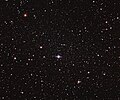Αρχείο:Carina Dwarf Galaxy.jpg

Μέγεθος αυτής της προεπισκόπησης: 719 × 600 εικονοστοιχεία . Άλλες αναλύσεις: 288 × 240 εικονοστοιχεία | 576 × 480 εικονοστοιχεία | 921 × 768 εικονοστοιχεία | 1.228 × 1.024 εικονοστοιχεία | 2.456 × 2.048 εικονοστοιχεία | 3.771 × 3.145 εικονοστοιχεία.
Εικόνα σε υψηλότερη ανάλυση (3.771 × 3.145 εικονοστοιχεία, μέγεθος αρχείου: 5,64 MB, τύπος MIME: image/jpeg)
Ιστορικό αρχείου
Κλικάρετε σε μια ημερομηνία/ώρα για να δείτε το αρχείο όπως εμφανιζόταν εκείνη τη στιγμή.
| Ώρα/Ημερομ. | Μικρογραφία | Διαστάσεις | Χρήστης | Σχόλια | |
|---|---|---|---|---|---|
| τελευταία | 13:14, 24 Φεβρουαρίου 2015 |  | 3.771 × 3.145 (5,64 MB) | FDMS4 | Reverted to version as of 14:03, 28 June 2011. |
| 03:00, 24 Φεβρουαρίου 2015 |  | 3.768 × 3.144 (5,78 MB) | SteinsplitterBot | Bot: Image rotated by 180° | |
| 14:03, 28 Ιουνίου 2011 |  | 3.771 × 3.145 (5,64 MB) | Jmencisom |
Συνδέσεις αρχείου
Τα παρακάτω λήμματα συνδέουν σε αυτό το αρχείο:
Καθολική χρήση αρχείου
Τα ακόλουθα άλλα wiki χρησιμοποιούν αυτό το αρχείο:
- Χρήση σε af.wikipedia.org
- Χρήση σε ar.wikipedia.org
- Χρήση σε ast.wikipedia.org
- Χρήση σε ca.wikipedia.org
- Χρήση σε de.wikipedia.org
- Χρήση σε en.wikipedia.org
- Χρήση σε es.wikipedia.org
- Χρήση σε fi.wikipedia.org
- Χρήση σε fr.wikipedia.org
- Χρήση σε he.wikipedia.org
- Χρήση σε id.wikipedia.org
- Χρήση σε it.wikipedia.org
- Χρήση σε ja.wikipedia.org
- Χρήση σε ko.wikipedia.org
- Χρήση σε mk.wikipedia.org
- Χρήση σε nl.wikipedia.org
- Χρήση σε no.wikipedia.org
- Χρήση σε pl.wikipedia.org
- Χρήση σε pt.wikipedia.org
- Χρήση σε ro.wikipedia.org
- Χρήση σε ru.wikipedia.org
- Χρήση σε si.wikipedia.org
- Χρήση σε sk.wikipedia.org
- Χρήση σε tr.wikipedia.org
- Χρήση σε uk.wikipedia.org
- Χρήση σε vi.wikipedia.org
- Χρήση σε www.wikidata.org
